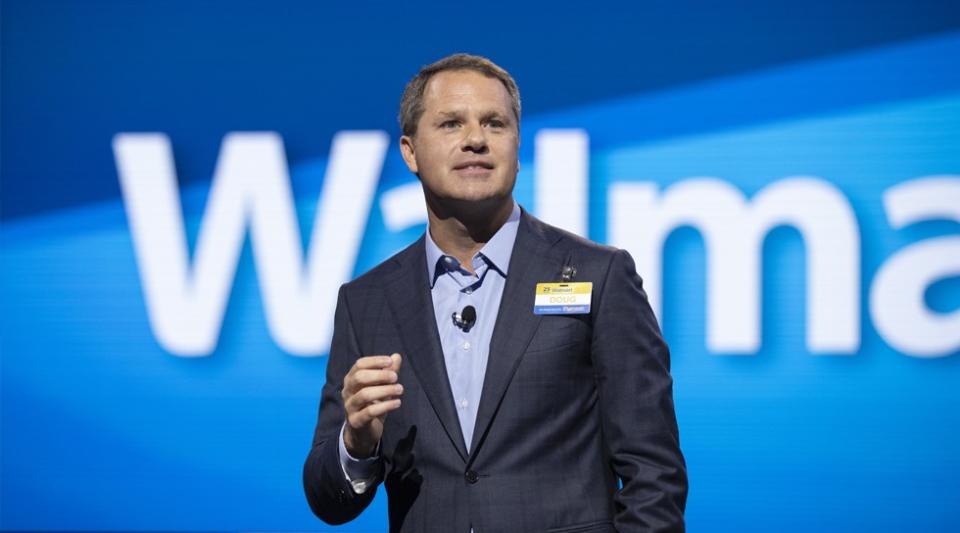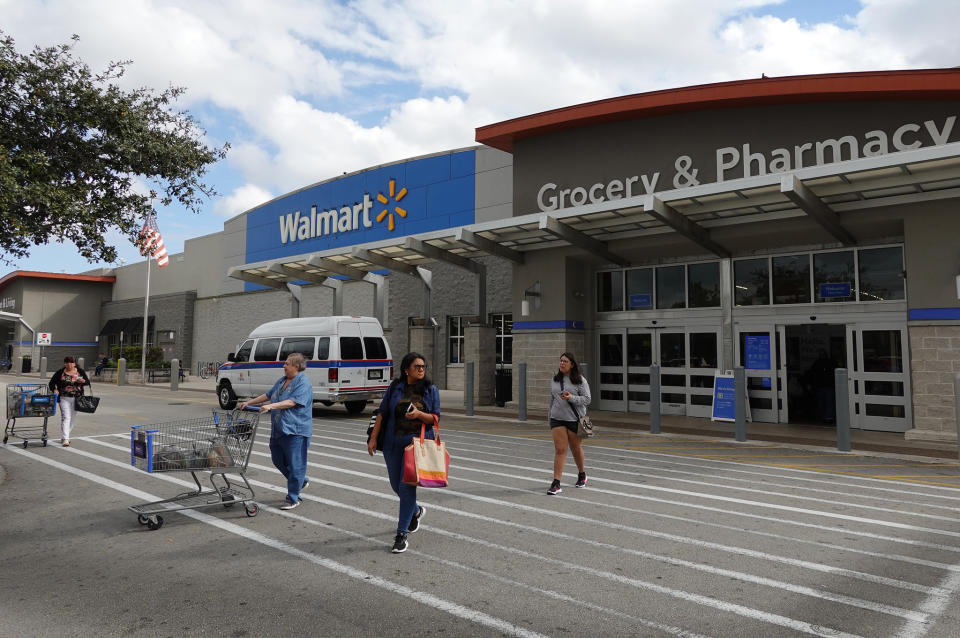The Consumer Mystery: How Retail Copes in an Uncertain World
- Oops!Something went wrong.Please try again later.

Consumers have always been a mystery.
Billions of decisions: What to buy, where to buy it, how much to spend, combine with the needs and wants of the multitudes, the economic realities of the moment and the goods for sale to come together and power the economy.
More from WWD
Personal consumption expenditures make up 70.8 percent of the $20 trillion U.S. economy. But consumers are skittish right now, and spending habits have fluctuated post-pandemic due to inflation rates, bank failures and more.
As it stands, retail’s leaders are left to guess where shoppers are and where they’re headed.
Right now, it’s Walmart Inc. chief executive officer Doug McMillon who seems to know best how to connect with the average person. (Courting luxury’s 1 percent is another game, entirely.)
The Walmart formula includes having oodles of scale, strong brick-and-mortar and digital offerings and a value-based business model that in tough times keeps both lower-income shoppers afloat and attracts high-income consumers wanting to save.
That — plus some retail basics.
“It’s a great time just to be a really good merchant,” McMillon told analysts on a conference call Thursday. “Like in our stores, when I think about general merchandise, whether that’s apparel or hardlines, we’re focusing our store leadership and our store associates on standing tall in those areas. And because inventory is in a better spot than it was last summer, for example, they can focus more on that rather than just dealing with the flow of inventory that was coming in.”

Reported Thursday, Walmart drove first-quarter sales up 7.6 percent to $151 billion, adding nearly $11 billion to the top line from a year earlier. Net income fell 18.5 percent to $1.7 billion, but adjusted earnings per share tallied $1.47, coming in 15 cents ahead of the $1.32 analysts expected, according to FactSet.
The flagship Walmart U.S. division saw comparable sales jump 7.4 percent excluding fuel, with transactions up 2.9 percent and the average ticket price increasing 4.4 percent — suggesting the retailer was both seeing more shoppers than it was a year ago, and that those shoppers were spending more money.
Consumer cash is being directed to food and consumables, which saw sales increase in the low double digits, while general merchandise sales showed a midsingle digit decline in the quarter at Walmart. The trends were echoed by rival Target Corp., where food, household essentials and beauty sold well in the most recent quarter, but impulse shopping across other categories slowed.
Walmart is making up for some of those non-essential sales online. The U.S. division’s e-commerce business, which carries more than 200 million apparel stock keeping units, showed significant growth in the quarter, gaining 27 percent.
“As we look ahead to Q2 and the rest of the year, we’re focused on getting our merchandise costs and [retail prices] down to fight inflation for our customers and members, which will help us with mix,” said McMillion, also citing a continued focus on pickup and delivery and “inventory management by item and category.”
“There are places to play offense and there are places to be more conservative,” he said. “We shouldn’t be treating every category the same way, and we aren’t. We’re playing offense where we should and controlling what we can control.”
While Walmart was able to adjust in the first quarter, the company’s chief financial officer John David Rainey underscored just how dramatically shoppers are changing right now.
“At the headline level, consumer spending has proven resilient,” Rainey said. “But below the surface, we continue to see signs that customers remain choiceful, particularly in discretionary categories.
“In Q1, we saw a nearly 360 basis point shift in U.S. sales mix from general merchandise to grocery and health and wellness,” the CFO said. “To benchmark, the magnitude of this shift exceeds the 330 basis points of category mix shift we experienced in all of last year.”
That kind of swing at a company as large as Walmart — with the last quarter alone outpacing a year of consumer shifts — shows just how fast change is sweeping through retail right now.
Neil Saunders, managing director at data and analysis firm GlobalData, described the current landscape as a “cost-of-living crisis” that is acting as “a recruiting sergeant for Walmart, increasing customer numbers.”
“This includes among higher-income shoppers, more of whom are now using Walmart on a regular basis for groceries and household goods,” Saunders said. “The good news here is that new shoppers seem to be sticking with Walmart — at least for the time being — but the less good news is that their activity is mostly confined to staples and necessities, and few are crossing the aisle to shop general merchandise. In our view, improvements to the proposition, including stocking more aspirational brands in areas like beauty, and strong online service levels have helped with the retention of higher-income consumers.”
Target — another retailer that proved to be a pandemic powerhouse — said this week that it was successfully appealing to shoppers with “affordable joy,” but posted a sluggish first quarter with flat comparable sales an a 0.6 percent increase in revenues to $25.3 billion.
It is Walmart that seems to have the consumers on its side right now.
Arun Sundaram, senior equity analyst at CFRA Research, said: “It’s clear that we’re entering a tougher consumer spending environment. However, Walmart seems to be well-positioned to gain market share, especially in its core grocery business. We’re also positive on various margin-accretive initiatives, including automation, advertising and third-party marketplace, all of which should result in stronger, long-term earnings growth.”
Sundaram kept his “buy” rating on the retailer’s stock and lifted his 12-month price target on its stock by $2 to $171. That suggests Walmart, which saw its shares close up 1.3 percent to $151.47 on Thursday, still has a good deal to run.

That sense — that a tougher consumer environment is coming — is widespread, especially with the Federal Reserve playing chicken with consumers, trying to raise interest rates to reduce demand and keep inflation from overheating the economy.
Even Johann Rupert, chairman of Cartier-parent Compagnie Financière Richemont, is looking for a volatile year ahead in the U.S. and described the Fed’s sudden move to higher interest rates as “reckless.”
“The United States will not be as buoyant as a year ago,” Rupert said last week. “Will it return? Yes. Will it be soon? I actually think we’re in for a harder landing than we hope for because we do expect it. Will it affect us? Yes. It will affect everybody.”
Total U.S. retail and food service sales for the fiscal first quarter —including February, March and April — rose 3.1 percent from a year ago, according to a Census Bureau report on Tuesday. In April, sales inched up just 1.6 percent showing a deceleration.
And while consumers are spending more, they might not actually be getting more, with inflation sitting at generational highs and degrading purchasing power all around.
To Wall Street, where growth is often prized above all else and any slowdown is a hint that the economy is about to come tumbling down, the retail sales reading was a bad sign.
But experts focused more squarely on the consumer saw something else — shoppers that are still willing to spend despite all the economic angst.
“To me, the stability in these numbers is actually a good thing,” said Katie Thomas, who leads the Kearney Consumer Institute think tank, especially after “all the doom and gloom we’ve seen about the consumer.”
“There’s not actually this panic over money and inflation,” Thomas said. “People are kind of living their lives and I think they’ve actually gotten incredibly savvy about the decisions they want to make.”
Thomas said many experts look at the consumer through the financial lens of Wall Street and what their spending means for stock prices, instead of looking at the consumers themselves.
“The consumer in general is evolving,” Thomas said. “You’ve just seen two years of stabilization [in retail sales figures]. I would be way more concerned, personally, if the numbers were way up or way down right now, but I think steady-state positive is good.
“There hasn’t been this massive pullback in spending that we’ve been talking about for a year now,” she said. “At what point do we move from that being the story?”
That doesn’t mean the changes in spending patterns aren’t impacting companies or their stock prices. It all just might say more about the companies themselves, where they’re situated in the market and how their models are bearing up to shifts in consumer attitudes.
And as luxury goes from strength to strength and economic worries push more shoppers to the value channel, the space in between has only gotten trickier, with brands really needing to stand out in some way.
“We’ve been talking about this since the pandemic, this idea of the death of the middle,” Thomas said. “The middle has just gotten mushy; by trying to be everything to everyone, they’ve gotten to be nothing to anybody. Because consumers have so many options, [retailers in the middle] have lost a bit of their sense of selves.”
Being stuck in the middle — in that nebulous space between discount and luxury — is harder than ever right now.
“You’ve got the Fed realigning interest rates trying to curb demand and consumers have been phenomenally resilient,” said Jonah Ellin, chief product officer at retail analytics firm 1010data.
But the consumer economy is not back to normal, Ellin asserts. Instead, retail has settled into the haves and have-nots.
“We’ve got a young generation that’s come into money who are frequently living at home and very oriented on the brands they care about, some are luxury brands and some are lifestyle brands. That’s driving a fair amount of purchasing power right now,” Ellin said.
The upper middle class and higher-end consumers generally are also doing well and spending.
Meanwhile, value consumers are more challenged and feeling the squeeze of inflation, but still find jobs to be plentiful with unemployment at 3.4 percent — a rate that before this year was not seen since the ’60s in the U.S.
If consumers up and down the income spectrum continue to spend, the Fed may continue to raise interest rates, which could lead to a deeper economic freeze.
But the betting by many right now is that the worst-case will be avoided as consumers pull back.
“I think it’s going to be a bit of a recession, but I think it’s going to be just that…a bit,” Ellin said. “Coming through the summer months, you’ll see a shift. People will start focusing on experiences, on vacation, on travel, their credit will get used and I think coming out of that, there’s many on the lower end of the spectrum who are going to have a harsh reality and for the upper end of the spectrum, they’ll tighten the purse strings a bit.”
Already, shoppers are proving to be skittish and vulnerable to signs of economic trouble — from a possible recession to the high profile and potentially disastrous showdown over the federal debt limit.

Consumer confidence dropped by 9.1 percent this month compared with April, according to preliminary reading of the University of Michigan’s Surveys of Consumers confidence index of sentiment.
“Consumers are worried that any economic downturn will not be brief,” said Joanne Hsu, director of the Surveys of Consumers. “Year-ahead expectations for the economy plummeted 23 percent from last month. Long-run expectations slid by 16 percent as well … Throughout the current inflationary episode, consumers have shown resilience under strong labor markets, but their anticipation of a recession will lead them to pull back when signs of weakness emerge. If policymakers fail to resolve the debt ceiling crisis, these dismal views over the economy will exacerbate the dire economic consequences of default.”
So that’s it — retailers just need to navigate a world where consumers are constantly changing their habits and priorities post-pandemic, while pressured by high inflation and worrying about the next shoe to drop.
Easy, right? Doug McMillon has it figured out, for now at least. Change is still coming fast.
Best of WWD

